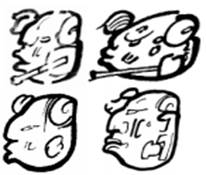


TOK.p23.r1.c4 = BMM9.p14.r1.c2 K&L.p31.#6 & K&L.p46.#2 Schele
PAL TI CT A4
IXIIM / na IXIM IXIM / JUUN / na IXIM?/AHAN?
· No glyphs given in K&H.
· Should be read as JUUN when it is the head variant of the number 1.
· Means TMG or “maize in general” (as opposed to FMG = AJAN “fresh ear of corn”) – reference?
· It means the TMG / IXIIM = “grain of (younger) maize”) as opposed to the FMG / AJAN = “ear/cob of (older) maize”– see “1” and “8” as numbers, AT-E1168-lecture6.t0:42:12-43:02 (TMG/“1”) vs AT-E1168-lecture6.t0:49:55 (FMG/“8”).
· Features:
o Main distinguishing features (all optional) are:
§ “JEWEL” on forehead, while IX / IXIK has a regular tuft of hair (HUN reading suggested in BMM9.p10.pdfp10..r3.c3 – BMM9 does not write long vowels).
§ Absence of long flowing strands of hair on the right, which IXIK has.
§ Presence of 2-5 maize kernels in the head (optional).
· Do not confuse this with the visually similar IX / IXIK “woman, lady, female”, see IX / IXIK.
o Features in common (hence the confusion, also optional):
§ Can have an IL-element on the cheek.
§ Can have a fancy ear with earspool.
· Do not confuse IXIIM = “Tonsured Maize God” with the slightly similar day name IMIX.
o It’s almost a “swap” of the two syllables.
o IMIX is not the Classic Maya pronunciation of this day name anyway – this is just the Yucatec version, used by epigraphers because the Classic Maya pronunciation is not fully clear.
· PAL TI CT A4 is transliterated as AHAN? in Villalobos-EGM-KJP.p89, and as IXIIM in Guenter-TKJP.p26. I have put it under IXIIM, as I see JUUN as a forehead ornament, and also next to the complex ear.